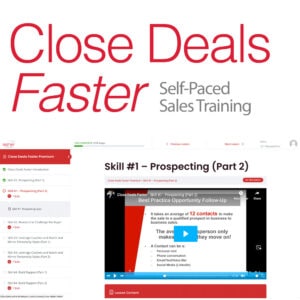18 for 2018 – Closing Sales Techniques

You can never learn enough closing sales techniques. Even if you don’t use all of them over the course of your sales career, studying closes helps develop a greater competence with the ones you DO use.
In my book, Close Deals Faster: The 15 Shortcuts of the Asher Sales Method. I cover ten of the most popular closes used by the elite of the sales world. In this post, I will give a brief rundown of these plus eight bonus closes to add to your arsenal.
Bookmark this post, save as a PDF, or print it out to remind you of them during your work week. These are money makers!
- Direct
The most simple close there is. Once you identify what a buyer needs and present your product or service, you just use a statement or question which makes the buyer comfortable enough to move forward. Something like, “It seems we can solve this for you. How do you feel about moving forward?”
- Assumptive
Here, the salesperson assumes the buyer has decided to buy and asks a question to help the buyer take the next logical step, as if he or she already agrees to own it. “I feel our XP-1000 would be a great addition. Would we be installing it in this corner?”
- Alternative
This is one of those classic closing sales techniques which is still effective despite so many people knowing about it. Similar to the Assumptive Close, you assume the deal is done, and you are simply confirming some detail of the purchase. “We have three units in our downtown warehouse. Would you prefer delivery Tuesday or Wednesday?” You can also use this to offer two different products or services: “Would the Deluxe or Platinum subscription work best?”
- “I recommend…”
This is an excellent close to use with buyers who know you well or for whom you have already established a role as a trusted advisor. This type of buyer is likely to consider your recommendations with greater weight than other buyers. You can use definitive statements you want them to act on, such as “I feel you are underperforming due to your limited marketing budget. I recommend you invest a but more and try our analytics add-on, as it will give you deeper insights into your site visitors. How do you feel about this?”
- Pilot Project
One of the best closing sales techniques is to let a buyer sample the product or service. This is very easy to do in B2C, but becomes harder to do in complicated B2B or government sales. A way to accomplish this is to offer a test run with a small part of a project or operation. You might offer, “I understand you would prefer to work with a vendor with an established track record in the region. Since we are new to the area, I suggest we start with a pilot project of 5 licenses. Then, if we beat your specs, we can talk about expanding. It’s very low risk…how do you feel about starting this way?”
- When or If
Use this when you are hit with an objection, and you know you can satisfy it by modifying the terms of the deal, product, or service. If you simply concede, the buyer can keep asking for concessions or not close at all. So, you offer to concede with a caveat. “Can you commit to a 12-month subscription when my boss agrees to a 10% discount?” or “If we shave off two weeks from the delivery, will you be ready to pay in full?”
- Timeline Technique
Buyers often leave purchasing decisions to the last minute, and this can result in headaches for vendors who have to deal with rush orders and emergencies. An excellent way to not only show your worth as a trusted advisor, but also get the sale today rather than six months from now is the Timeline Technique.
Inform the buyer that, based on their project deadlines, things have to be set in motion soon. For example, “In order to complete by October, we have to get work begun no later than August 1st, and there is a two month lead time for plans and materials. We would need to get an agreement and deposit right away in order to hit your deadlines. Is your team ready to move forward?
- Test It Out (Puppy Dog)
This and the Pilot Project are cousin closing sales techniques. The difference between them is that the seller using Test It Out receives no payment from the buyer. This makes it much less attractive, but sometimes it’s the only way to get a buyer to even consider a purchase.
So, you simply give a sample, trial, or temporary license for no charge with the hopes that buyer finds it indispensable and buys it. You should always try to get a commitment in return, such as,” At the end of the trial, would you be prepared to commit to a purchase if it meets specs?” In this way, you eliminate many who would just waste your time and resources.
- Window of Opportunity
Some closing sales techniques apply more pressure than others. The window of opportunity close is a higher-pressure technique based on a deadline or time limit, so it requires integrity and honesty in application. Don’t use it if there is no actual time limit. If the buyer finds out later that others have gotten the same or better deal after the deadline, it could endanger that customer relationship.
Tell the client that if they do not commit now, they will lose the opportunity. For example, “Our model XT-5000’s are selling fast. If you want to lock in 10 units from the remaining stock, I need a deposit to hold them.” This is perfectly valid if you are indeed in danger of running out of stock…not so much if you have 10,000 units tucked away in a warehouse.
- Return on Investment Close
For this close to work, you have to do your homework as to whether the deal makes financial sense. Once you prove to yourself that the deal provides a worthwhile return of at least 15% to the buyer, that gives you the confidence use this close.
A statement I use is, “Will you look at the numbers and decide for yourself if they make sense?” You are forcing the buyer to use logic here, and if the ROI is compelling, then they are likely to buy. To not buy would be to admit they do not have buying authority, have an ulterior motive, or there is some other undisclosed factor. This includes objecting to you or your company personally, so ensure they have bought YOU first before trying this one.
- Porcupine
Yes, some closing sales techniques have odd names. As described by Tom Hopkins in How to Master the Art of Selling, the Porcupine involves answering a question with another question. Imagine someone throws you a porcupine. What do you do? Throw it back of course!
When a prospective buyer asks, “Does the manual come with Spanish and French translations?” the proper response would be “Do you need it in Spanish and French?” When the buyer says “Yes, we have a multicultural operations crew,” well he is basically sold if you can satisfy that concern.
- Feel
Even corporate buyers buy emotionally, and so the word “feel” carries a lot of weight when trying to close. Rather than ask “What do you think about our solution?” try “How do you feel about our solution?” This tiny modification can make all the difference in the world as it involves the buyer’s emotional brain. If you don’t get a positive response, at least you have a better chance of surfacing the true objections to address.
- Freebie
This is one of those closing sales techniques which can help you in a tough situation, when you have expended all other efforts and the buyer still will not close despite addressing all objections. He or she still wants to think about it, and there is no good reason they are not moving forward from what you can see.
So, bribe them. Just kidding! Actually what you do is sweeten the deal with a freebie. That is why this is a last-ditch solution, because it will eat into your profits. Make sure your managers are in accord with the freebie, and be willing to put some of your own skin in the game (aka give up some commission) in order to make the deal work.
The conversation would go something like this: “You are a tough negotiator. I thought I could close you but I respect your decision. I really want to earn your business however, so before I take this opportunity out the door, could I convince you to sign the contract today if I throw in free freight?”
- What happens next?
You’ve asked for the order. You feel you are so close. The prospect hems and haws, wants to think about it, and won’t sign. You’ve handled all objections and tried other closes, to no avail. It’s time to put the buyer in the driver’s seat and let him or her decide what happens next. “Okay, I feel that we are very close, but I hear you — we won’t get a signed contract today. What happens next?”
An alternate phrasing is “What’s our next step?”
- The Thermometer
Gauge how hot or cold the buyer is on the deal using the Thermometer Close. “One a scale of one to 10, with 10 being absolutely ready to proceed and one being very far from it, how high would you say you are on the scale?” Let the prospect reply, then ask “Got it. What is keeping you from being at 10?”
Handle the objections thus uncovered, and you have a new customer.
- Take It Away
Some would call this “using reverse psychology.” It’s used only on tougher cases who have strong price objections. When an impasse is reached, you start to take away some of the options and add-ons. “Well, I think we can reach your price range if I give you a 90-day warranty rather than a two year. You’d be on the hook for any repairs after three months, but at least it will be cheaper for you upfront. And we would only be able to do our basic package rather than the premium which you so liked. This will leave you without these benefits [list them out] but I understand if you cannot afford it.”
People don’t like things taken away from them. With this close, many buyers will decide to go forward so they get full satisfaction without giving something up. Ego also comes into play here: insinuating they do not have enough money might stir their pride enough to buy — just to prove you wrong!
Be careful to show empathy, not be insulting, or this close could backfire.
- The Big Picture
Sometimes during a sale, both the seller and the buyer get so lost in the details and the back-and-forth that the big picture gets forgotten. Deals which are great for both parties can fall apart on one or two trivial sticking points, such as a few dollars or a refund/return policy.
A way to unstick the prospect from stubbornly holding on to these minor stumbling blocks in order to kill the deal is to remind them of the big picture. It’s the reason why you are selling them your product or service in the first place. For example, “I am sorry I could not get a better price for you. But before I go, I just want to clarify something: what problem were you really trying to solve when you agreed to see me? [let prospect answer] In the big picture, is this small price difference more important than that?”
Video Link – http://video.asherstrategies.com/skills-reinforcement/asking-questions-and-listening
- Little versus Big Mistake
Use this one with buyers who are afraid of making a mistake. Emphasize that a bigger mistake is to do nothing. “I know this can seem like a big investment and you are afraid of making a mistake. But what is worse, a possible little mistake you could recover from, or the guaranteed bigger mistake of doing nothing and letting things get worse?”
Whew! This took some time and effort to put together, but I know these closing sales techniques will help grow your business and put money in the coffers — so it’s worth it. Contact me if you need further sales training help. To your success!






